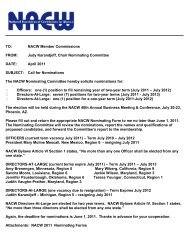1 THE ABC's OF PROGRAM EVALUATION
1 THE ABC's OF PROGRAM EVALUATION
1 THE ABC's OF PROGRAM EVALUATION
You also want an ePaper? Increase the reach of your titles
YUMPU automatically turns print PDFs into web optimized ePapers that Google loves.
1<br />
<strong>THE</strong> ABC’s <strong>OF</strong> <strong>PROGRAM</strong> <strong>EVALUATION</strong><br />
(An accompaniment to the 2010 NACW Achievement Award Criteria and Application)<br />
BASIC <strong>EVALUATION</strong> GUIDE: There are two basic types of evaluation: PROCESS and OUTCOME.<br />
1. PROCESS <strong>EVALUATION</strong>:<br />
Process evaluation tracks the implementation of your program: How was your program implemented?<br />
SAMPLE PROCESS GOALS:<br />
In October 2009, implement domestic violence in the workplace training for 50<br />
managers/supervisors in Company __X .<br />
By June of 2009, have all Commission staff certified to conduct domestic violence in the<br />
workplace training.<br />
Questions to consider:<br />
Resources:<br />
What resources were used to implement the program? How many staff members were used to<br />
implement the project? What was the cost of the program? How did actual expenditures compare<br />
to the amount budgeted?<br />
Program planning activities:<br />
What stakeholders were involved in the program planning and implementation? What types of<br />
relationship building activities took place to facilitate partnerships? Who developed the program?<br />
What data was collected or used to justify the need for your program? What was the intended scope<br />
of your program compared to the demonstrated need? What types of training did staff have to<br />
partake, in order to appropriately implement the program?<br />
Program activities:<br />
What program activities took place? How were the activities implemented? What activities were<br />
implemented as planned? Which activities were not implemented as planned? What changes were<br />
made to the original plan as the program progressed? What barriers did you experience?<br />
Level of participation:<br />
Who was your target audience? What was the attendance rate for your activities? Who attended?<br />
What were your participants’ backgrounds and needs? Who did not attend? Why or why not?<br />
How did you conduct your outreach? Did your participants enjoy the program? Were they satisfied?<br />
What were their likes and dislikes? How large is the potential community of participants who could<br />
be served if the program was expanded? Did you reach your target number of participants?<br />
Did participants stay for the entire program? Were there retention issues?
CONCRETE EXAMPLES <strong>OF</strong> HOW TO COLLECT DATA:<br />
2<br />
Needs assessment data including local statistics which demonstrate a need for your program,<br />
focus groups with key stakeholders, etc.<br />
Participant attendance and retention rates<br />
Detailed demographics regarding participants<br />
Number of new volunteers, members, or partners<br />
Stakeholders or funders recruited<br />
Level of staff and/or Commissioner involvement: number of meetings, type of expertise used,<br />
hours devoted to project development and implementation<br />
Brief narratives about development process including successes, barriers encountered in<br />
planning and implementing program<br />
Satisfaction surveys<br />
Marketing conducted including flyers distributed, press releases, etc.<br />
2. OUTCOME <strong>EVALUATION</strong>:<br />
Outcome evaluation tracks the impact your program: What effect did your program have? What<br />
specific changes resulted from your program?<br />
SAMPLE OUTCOME GOALS:<br />
After completing the half-day training on domestic violence in the workplace, managers and<br />
supervisors will be able to list their three core responsibilities.<br />
By December 2009, managers who completed the domestic violence in the workplace training<br />
will distribute educational brochures regarding employee rights and benefits to their employees.<br />
Questions to consider:<br />
Behaviors:<br />
Do participants behave differently because of your program? Did people’s behavior change as a result<br />
of your program? What overt/visible changes are evident because of your program? How is the world<br />
different because of your program?<br />
Knowledge:<br />
Did participants/individuals obtain new knowledge and facts because of your program? Have myths or<br />
misinformation been dispelled? Have they identified new resources? Have participants obtained<br />
information that they can apply in their communities (how useful is the information)?<br />
Attitudes:<br />
Have people’s values and/or attitudes been impacted as a result of your program? Have participants<br />
changed their thoughts about a particular issue? Have individuals’ convictions become strengthened<br />
by your program? Has your program provided an opportunity to evaluate existing belief systems as<br />
they impact women and girls?
Short-term Impact:<br />
Changes that can be observed within 6 months or less of your intervention/program<br />
Long-term Impact:<br />
Changes that can be observed after 6 months or longer of your intervention/program<br />
CONCRETE EXAMPLES <strong>OF</strong> HOW TO COLLECT DATA<br />
3<br />
Number of requests for materials or information<br />
Number of new referrals<br />
Pre- and post-test surveys or questionnaires that assess changes in knowledge, attitudes,<br />
and feelings<br />
Assess “change in confidence” of your stakeholders, participants regarding their ability to<br />
manage identified problem. Question: On a scale of 1 to 10, how confident are you that you<br />
would appropriately respond to an act of violence in your department? (Pre- and post)<br />
Assess “change in intent” that your target audience will take action. Question: On a scale of<br />
1 to 10, how committed are you to violence prevention policies in your department? (Pre- and<br />
post)<br />
Follow-up surveys/ interviews/focus groups that assess knowledge/attitudes/feelings<br />
Organizational indicators related to your program, i.e., number of follow-up contacts about<br />
domestic violence training<br />
Social/community indicators related to your program, i.e., number of protective orders issued<br />
Logic models which map out the connection between your program activities, short-term<br />
outcomes, and long-term outcomes<br />
NACW 01/2010










